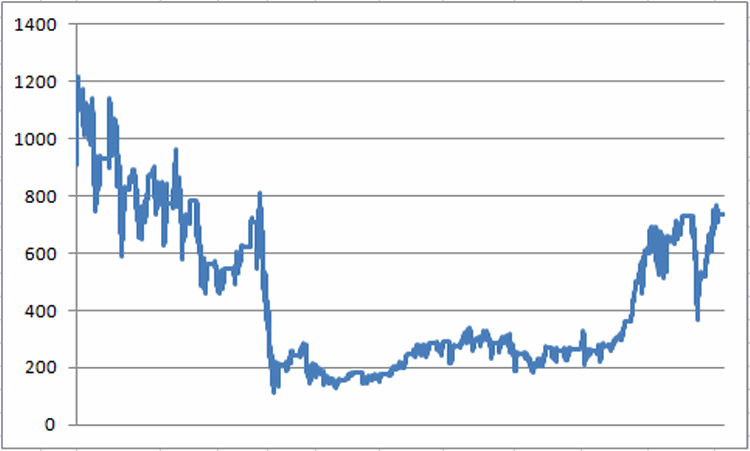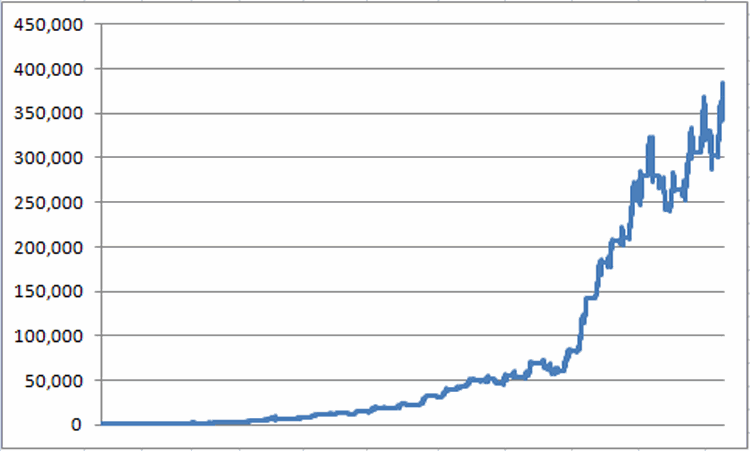Alright, last time out I wrote about the Coppock Guide (http://tinyurl.com/ndnvfbo), a long-term indicator invented by a guy named, well, Coppock, what else? I soon received several missives informing me that the proper name was Coppock Curve or Coppock Indicator or – as this Coppock character himself called it initially – Trendex, or, just for fun – the Very Long Term Momentum Index.
So in the interest of all-important diversity I considered referring to it heretofore as the Coppock Trendex Very Long Term Momentum Guide Curve. Fortunately, I let the urge pass.
This time out we will combine this indicator with another and examine the results.
The “Other” Indicator
The “other” indicator in this story is none other than that age old relic of an indicator, most commonly known as the “Golden Cross.” Although I’d be willing to bet that there is at least one person out there who will insist that I refer to it as the “Golden Average of Two Averages of Prices Moving Independently but Occasionally Intersecting Thereby Triggering Lots of Market Followers to Feel Compelled to Do Something.” Sorry to disappoint but I am already a little tired so we will simply proceed using the “Golden Cross” moniker.
For the benefit of the approximately four people out there who have never heard of this well worn indicator, it simply involves noting the position of the 50-day moving average of closing prices relative to the 200-day moving average of closing prices. If the 50-day crosses above the 200-day average this is a “bullish golden cross”, and if the 50-day crosses below the 200-day average this is a “bearish golden cross.” Figure 1 displays the Dow Jones Industrials Average from 2007 through 2010.
As you can see, the idea is that the Golden Cross will typically do a good job of keeping an investor in gear with the major trend of the market (except of course for when it doesn’t. We “trader types” typically refer to these periods as “whipsaws.” Come to think of it, we “trader types” more often refer to them as “#$%^ whipsaws” – but I digress). Figure 1 – Dow Jones Industrials Average with 50-day and 200-day moving averages (Courtesy: AIQ TradingExpert)
Figure 1 – Dow Jones Industrials Average with 50-day and 200-day moving averages (Courtesy: AIQ TradingExpert)
Rather than comparing the performance of Coppock versus Golden Cross, what I want to do is combine them.
Combining Coppock Guide and Golden Cross
Using monthly data for the Coppock Guide and daily data for the Golden Cross, I examined the results since August of 1900 (Do I know how to have a good time or what?).
-I designated the Coppock Guide to be bullish if the latest monthly reading was above its monthly reading two months ago and bearish if the latest monthly reading was below its monthly reading of two months ago.
-I designated the Golden Cross to be bullish if the 50-day moving average was above the 200-day moving average and vice versa.
From there each day was given a daily rating designated as:
0 = if neither indicator was rated as “bullish”
1 = If one indicator was rated as “bullish” but the other was not
2 = If both indicators were rated as “bullish.”
The results were “interesting.”
(“Interesting”) Results
Figure 2 displays the growth of $1,000 invested in the Dow Jones Industrials Average since 1900 only on those days when the daily rating was 0 or +1.
Figure 2 – Growth of $1,000 invested in Dow Jones Industrials Average only when daily rating is 0 or +1 (8/30/1900 to 2/7/14)
As you can see, the market had some great runs and some horrific declines during 0 and +1 periods. It does not seem like a good idea to just say you are out and out bearish if the reading is 0 or +1, still, an original investment of $1,000 starting in 1900 would now be worth $737. This represents a 114 year return of -26%. I am going to go out on a limb and assume that you are looking for something a tad higher.
To that end, note that Figure 3 displays the growth of $1,000 when the bullish daily rating was +2. In other words, the portfolio is invested in the Dow only when both the Coppock Guide and the Golden Cross are bullish. This test assumes that no interest is earned while in cash. Figure 3 – Growth of $1,000 invested in Dow Jones Industrials Average only when daily rating is +2 (8/30/1900 to 2/7/14)
Figure 3 – Growth of $1,000 invested in Dow Jones Industrials Average only when daily rating is +2 (8/30/1900 to 2/7/14)
As you can see, these results are – what we “quantitative” types refer to as – “better.”
For the record, $1,000 invested in the Dow only on days with a +2 reading grew to $366,993, or +36,599%.
It is interesting to note that this “system” spent just 39.2% of the time in the stock market. Given that it spends a lot of time in cash, it might make sense to do something besides stick the money in a mattress.
Adding Interest
If we assume that the system earns interest at a rate of 1% per year while out of the stock market, the growth of $1,000 balloons to $774,895, or +77,390%.
So we have a return of +77,390% when the daily rating is +2, versus -26% for all other days.
This is what we “quantitative” types refer to as “statistically significant.”
Summary
Now I hate to rain on my own parade but for the record, this blog offers “education”, not “recommendations.” As such, the real purpose of the model presented here is not to convince you to use it to trade. The real purpose is to get you to think in terms of starting with the simplest ideas and using them as building blocks to create a useful trading method of your own.
But whatever you do, don’t call it the “Very Long Term Momentum Index.” Because apparently, that one is already taken….
Jay Kaeppel


Jay: A little confused on coppock curve date………first article says 3 months ago, latest article says 2 months ago. Today is Feb 11. Are we to compare today’s coppack number to Nov 29, 2013 or Dec 31, 2013. Thanks
Drawing a blank on “3 months ago”, in the first article. Need to double check. In the second article it is definitely 2 months ago. The comparison is made at the end of the month and the reading remains unchanged until the next calculation at the end of the following month. The Golden Cross is tracked on a daily basis. Jay
I´m sorry but still dont get the same results. According to my number, buy and hold will make $260,000, your method $146,000 being 42.5% time in the market. Which is not bad at all
A simple golden cross $182,000 being 64% time in the market.
I used a daily compounding in the buy and hold and a monthly compounding in both your method and the golden cross.
In any case, it´s hard to pick a system that never gets short and still beats the buy-and-hold when the Dow has gone from 64 at the end of 1902 to 15,994
A bit confused about Coppock curve – since it is computed based on monthly data, is it constant for all days in a month?
Yes. If it is deemed bullish as of the last trading day of January, then it is considered to be bullish for all trading days in February. Jay